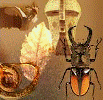Museum, University of Nebraska State
Date of this Version
1993
Abstract
Prehistoric Nebraskans used stone, bone, or even wooden tools for most tasks of everyday life that ranged from cutting a tree to making weapons to preparing foods . Bone and wooden tools are seldom found, but debris from the manufacture and maintenance of chipped stone tools is the most cornman evidence of human activity at prehistoric villages and camp sites. Some kinds of stone tools, such as end scrapers and bifacial knives, were perfected more than 10,000 years ago. Others, notably projectile points, were subject to continual refinements as revealed by changes in shape and size.
To understand the evidence of chipped stone tools, we must understand something about their manufacture and use. Not any kind of stone will do. A homogeneous, fine-trained stone with good fracturing properties is required. Cornman names for such stone include flint, chert, jasper, and chalcedony. Even fine-grained quartzites were used. Often people had to travel hundreds of miles to find the stone they required. Sometimes they traded for special varieties.



Comments
Published in Museum Notes (November 1993) No. 86: 4 p.